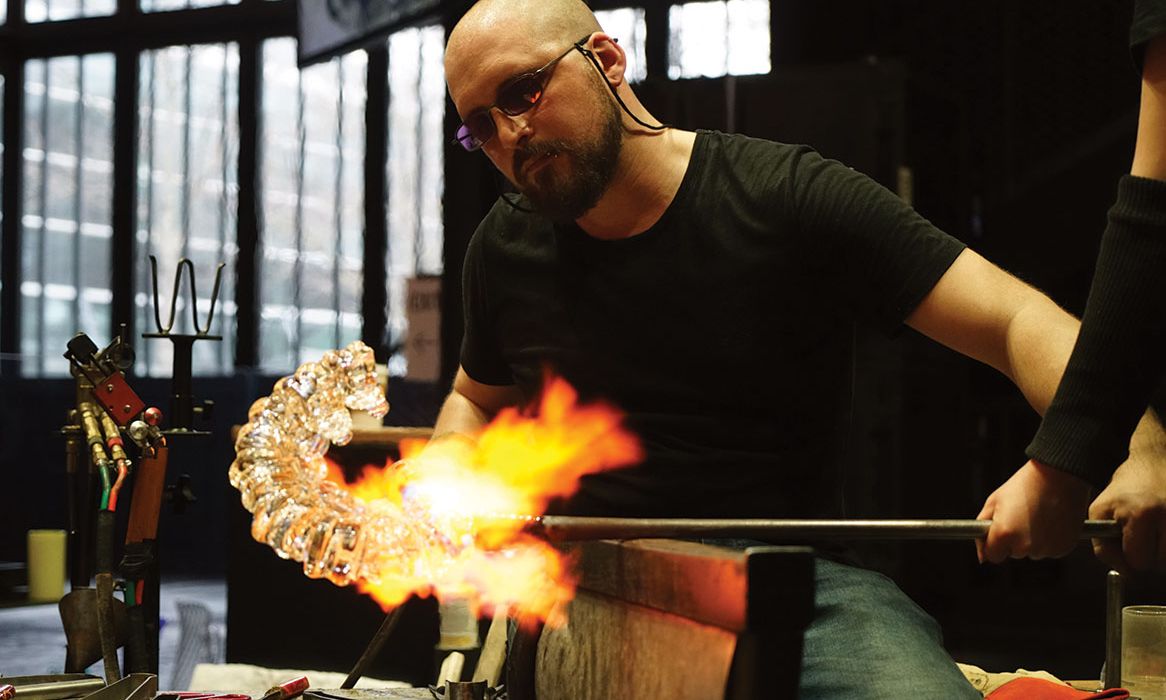Elliot Walker, who won the second series of the Netflix series Blown Away, works on a creation at the Corning Museum Courtesy of Corning Museum of Glass
On his second day in the US and the first of his residency at the Corning Museum of Glass in Corning, New York—part of his prize for winning the second season of Blown Away, Netflix’s glass art reality TV competition—the Hertford, England-based artist Elliot Walker was hard at work making glass vertebrae. The more than two dozen glass bones would eventually be fused into an impossibly looped spinal cord and affixed to a glass sacrum and coccyx. For the artist, whose winning installation on Blown Away resembled a fanciful workshop disaster, the residency was an opportunity to create a new series about labour and how it has reshaped human bodies and societies.
“I wanted to focus on the idea of work and labour—human labour, wage labour—and the psychological and physical effects that has on us as a species,” Walker says. This was made simpler thanks to the mid-April residency at the Corning Museum’s state-of-the-art hot shop and amphitheatre, which freed him from some of the labour of running a glass-blowing studio. “As a studio owner, that is a huge portion of your mental capacity. You’re married to this thing, this burning object that is keeping your business running but is also sucking all of the energy out of it—it’s great not to have to deal with that for a while.”
After the stint at the Corning in upstate New York, Walker and his collaborator and fellow glass artist Bethany Wood embarked on a veritable glass tour of the US, including a residency at the Pittsburgh Glass Center (another Blown Away prize) and attending the annual Glass Art Society conference in Tacoma, Washington (18-21 May). Along the way they also caught up with the artists Deborah Czeresko and Alexander Rosenberg, the winner and third place finisher of Blown Away’s first season. Like them, since being on the show Walker has witnessed a surge of interest in his work and in glass art in general.
“Having that global exposure in a familiar format has done unbelievable good for the perception of the material,” Walker says. “Now people see it as a medium for sculpture, for expression, as well as all the other things it does.”
This broadened perception was evident in the Corning’s spacious but often-packed studio amphitheatre, where visitors gathered to watch Walker realising his pieces with Wood and the hot shop staff. Whenever the resident commentator asked visitors how many of them had watched Blown Away, hands invariably shot up across the stands—some spectators cheered at the mere mention of the programme.
Despite all the visibility from reality TV and elsewhere—the United Nations has declared 2022 the International Year of Glass—Walker says glass still carries a stigma in the art world. “When applying to some fine art galleries, it’s like, ‘Oh no, we don’t show glass’. No matter what it is, you just aren’t showing glass as a material, just because it’s glass,” he says. “But the more artists are working with it as a material for sculpture, the sooner that will change.”

